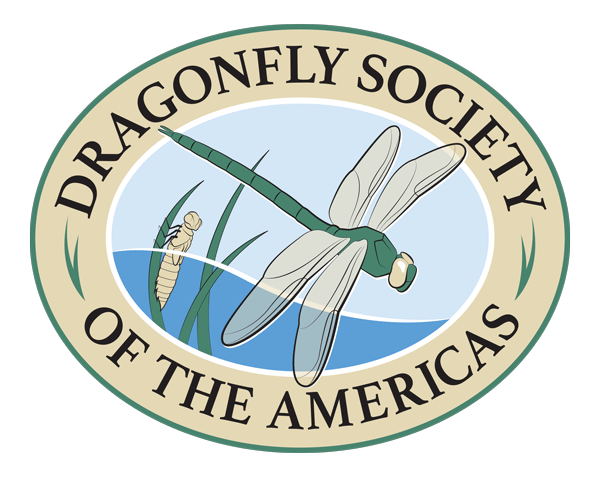June Species of the Month: Dot-tailed Whiteface (Leucorrhinia intacta)
June’s DSA species of the month is the Dot-tailed whiteface (Leucorrhinia intacta). Part of the large family Libellulidae (the skimmers or perchers), it is on the small side for dragonflies, at about an inch to an inch-and-a-quarter long (approximately 29-33 mm). Look for it in lakes and ponds from southern Canada, south to Kentucky, east to Nova Scotia and west to California (dipping down into New Mexico). Follow Illinois dragonfly chaser Gail Chastain as she looks for this common---but also sometimes elusive---species.
The Search for the Dot-tailed Whiteface
Field guides say that the Dot-tailed Whiteface dragonfly is common throughout southern Canada and the northern parts of the United States. I would not debate these experts, it’s just that although my husband, Steve, and I monitor a number of places in Illinois, we have not seen them at any of our sites. So, for the last few years we have traveled up to LeRoy Oakes Forest Preserve in St Charles, IL, about 45 miles west of Chicago, to find them. Leroy Oakes has a variety of natural features; prairie, woodland, creek, seeps and more. It’s not too far from where we live in Wheaton, IL, and they seem to have a nice population.
Dot-tailed Whiteface (Leucorrhinia intacta), LeRoy Oakes, FP (2021). Photo by Gail Chastain.
As its family name indicates, the Dot-tailed Whiteface can be seen perching on objects during the day. There are seven Whitefaced Leucorrhinia species in the United States with the Dot-tailed Whiteface being the most widespread, found in 34 states in the U.S., and 10 Canadian provinces. Its conservation status changes with location, but overall it is considered to be abundant and secure.
Leucorrhinia is an appropriate name of this group of dragonflies. Leuco comes from the Greek meaning “white” as in leukocyte, the white blood cell. Rhina also comes from the ancient Greek meaning “nose.” The Dot-tailed species name intacta is a little more difficult. Intacta is from the Latin for “unblemished/chaste”. One suggestion I found when I investigated was that this referred to the lone spot on the male, but there is nothing to support this. So, I guess we can make up what we want!
The Dot-tailed Whiteface has a very apt common name. The male generally has a solid black body and legs, and both a yellow dot on the seventh segment of the abdomen, a creamy white face, and a small black basal wing spot.
Dot-tailed Whiteface (Leucorrhinia intacta), LeRoy Oakes, FP (2002). Photo by Gail Chastain.
The female Is more colorful. She has multiple yellow spots along the dorsal and side of the abdomen, and the last yellow spot on segment seven may be large and square-shaped. Females also have yellow stripes on the side (lateral surface) of segments of three and four. As the female matures, the dorsal spots will fade. When this happens, it’s easy to confuse females with males. Some females will also have a conspicuous amber patch where the wing attaches to the thorax.
Female Dot-tailed Whiteface (Leucorrhinia intacta), LeRoy Oakes, FB (2021). Photo by Gail Chastain.
Why are they at Leroy Oakes Forest Preserve, and not in other areas where we monitor closer to home? Probably because of the quiet waters in this preserve, which is their preferred environment.
Mallard (Anas platyrhynchos), On Quiet Pond, LeRoy Oakes, FP (2021). Gail Chastain.
These dragonflies look for wetlands such as bogs, marshes, swamps, sloughs and very slow streams with low aquatic plants to perch on. You can find them basking on the lily leaves on the water, or on vegetation nearby.
Dot-tailed Whiteface on water Forget-Me-Not (Myosotis scorpiodes), LeRoy Oakes, FB (2021). Photo by Gail Chastain.
Dot-tailed Whiteface (Leucorrhinia intacta), LeRoy Oakes, FP. Photo by Gail Chastain.
The Dot-tailed Whiteface dragonfly emerges in late spring here in Illinois, and flies a good part of the summer. You won’t have to look up for them! They don’t fly very high. With a territory that may be only four yards wide, they don’t fly very far, either. They prefer to stay near the water.
Dot-tailed Whiteface on Water-Lily (Nupar lutea), LeRoy Oakes, FP (2021). Photo by Gail Chastain.
Although the Dot-tailed Whiteface is not necessarily an active defender of its territory, the male will actively guard the female he has mated with while she lays her eggs by flying above her as she oviposits. The males may also grab or clasp other males in a behavior that is called “karate guarding,” and will hold them in tandem to keep that intruding male away from a female.
Dot-tailed Whiteface (Leucorrhinia intacta), LeRoy Oakes, FP (2021). Photo by Gail Chastain.
It’s a fun dragonfly to find and photograph. The bonus is that when we do find the Dot-tailed Whiteface dragonfly, we find so much more.
Eastern Tiger Swallowtail (Papilio glaucus) LeRoy Oakes FP. Photo by Gail Chastain.
Green Frog (Lithobates clamitans). LeRoy Oakes FP 2021. Photo by Gail Chastain.
Just one of the many perks of dragonfly chasing!
Gail Chastain has been an avid naturalist and photographer for most of her life but retirement allowed her to further these interests. In 2012, Gail started a wildlife monitoring project at Fermilab in Batavia, IL. Later, her focus changed to insect monitoring with her husband Steve Baginski. Since 2018, Gail and Steve have been Odonata monitors with the Morton Arboretum in Lisle, IL, at multiple sites.











